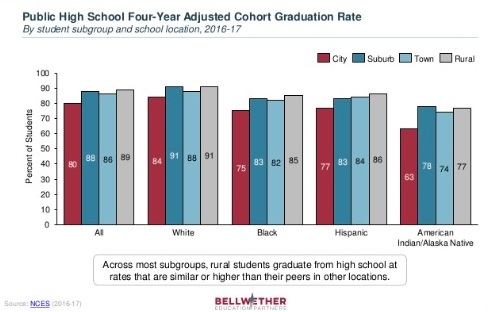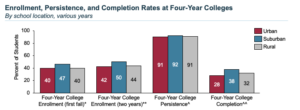From lobsters to bikes to HBCUs, Bellwether has covered a breadth of topics tied to rural education over the last six years. While we are by no means the first group to do in-depth research on rural schools and communities, we were among the first in the education reform community to begin thinking critically about policy solutions for rural schools. And as more and more of our peers have turned their attention to the rural context, we’ve realized that there’s a lack of basic understanding of the facts about rural schools and communities.
To help address that problem, we’ve put together a new resource: “Wide Open Spaces: Schooling in Rural America Today.”

This deck pulls together data and research on education, economic development, and more into a coherent fact base to explain the current state of rural communities and schools. It begins with an overview of the variation of communities within the rural designation in terms of their locations, economies, strengths, and challenges. For example, resort communities like Eagle County (Vail), Colorado and impoverished communities like many along the Mississippi Delta are both considered rural but have dramatically different geographic, economic, educational, and social contexts.
The second section looks closely at rural schools and their outcomes. Many rural districts face declining student enrollment and subsequent budget shortfalls on top of persistent challenges around student transportation and teacher retention. Despite these challenges, high school graduation rates tend to be higher in rural communities than urban communities.

But rural students tend to complete four-year postsecondary degrees at lower rates than their suburban peers.

While rural schools face many challenges, however, that’s not the full story. The final section of the deck focuses on the assets that rural communities have at their disposal, strengths that can build a foundation for meaningful and long-lasting change.
Rural community members tend to have tight social networks and deep roots, as well as individual, organizational, civic, cultural, and historical assets that can be harnessed to drive change. These may include community anchor institutions such as small businesses or chambers of commerce, natural resources such as water or land, and cultural and social assets such as strong community and family support systems.
Moreover, some rural communities host creative approaches to longstanding problems. Economic development initiatives, such as the Appalachian Regional Commission, or those supported by the Golden LEAF Foundation in North Carolina, for example, are helping to bridge the gap between K-12 schools and postsecondary options for rural students. There’s also early evidence that national philanthropists are starting to increase the funding they give toward rural communities. And the dozens of organizations already working in rural communities — many of which have been doing hard work long before the education reform movement began paying attention — will continue to do good work on behalf of students and families.
For in-depth analysis of the data, you can see our report here. To learn more about our previous work on rural education, click here.
December 5, 2019
Bleak Pictures of Rural Communities Are Not the Full Story
By Bellwether

Share this article
More from this topic
Meeting the Moment: How 4 Philanthropic Foundations Are Stepping Up Right Now
Teaching Interrupted: How Federal Cuts Threaten a Promising Teacher Residency Program
Does Increasing Graduation Requirements Improve Student Outcomes?
No results found.